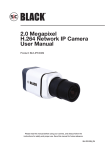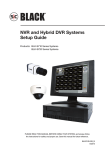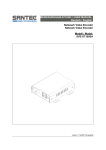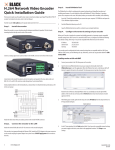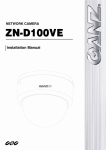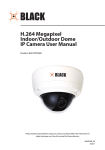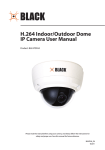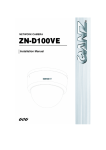Download Black BLK-IPE101 User manual
Transcript
® H.264 Network Video Encoder User Manual Product: BLK-IPE101 Please read this manual before using your encoder, and always follow the instructions for safety and proper use. Save this manual for future reference. BLK-IPE101_PM WARNING RISK OF ELECTRIC SHOCK. DO NOT OPEN. To reduce the risk of electric shock, do not remove cover (or back). No user serviceable parts inside. Refer servicing to qualified service personnel. CAUTION Operate this encoder only in environments where the temperature or humidity is within the recommended range. Operation in extreme temperatures or humidity levels may cause electric shock and shorten the life of the product. LEGAL NOTICE SC Black is a registered trademark of Supercircuits, Inc. Supercircuits products are designed to meet safety and performance standards with the use of specific Supercircuits authorized accessories. Supercircuits disclaims liability associated with the use of nonSupercircuits authorized accessories. The recording, transmission, or broadcast of any person’s voice without their consent or a court order is strictly prohibited by law. Supercircuits makes no representations concerning the legality of certain product applications such as the making, transmission, or recording of video and/or audio signals of others without their knowledge and/or consent. We encourage you to check and comply with all applicable local, state, and federal laws and regulations before engaging in any form of surveillance or any transmission of radio frequencies. Other trademarks and trade names may be used in this document to refer to either the entities claiming the marks and names or their products. Supercircuits, Inc. disclaims any proprietary interest in trademarks and trade names other than its own. No part of this document may be reproduced or distributed in any form or by any means without the express written permission of Supercircuits, Inc. © 2010 Supercircuits, Inc. All rights reserved. 11000 N. Mopac Expressway, Building 300, Austin, TX 78759 Sales/Support: 1.800.335.9777 | Fax: 1.866.267.9777 ii www.sc-black.com Table of Contents SECTION 1 Features. . . . . . . . . . . . . . . . . . . . . . . . . . . . . . . . . . . . . . . . . . . . . . . . . . . . . . . . 2 1.1 Front panel indicators and connectors. . . . . . . . . . . . . . . . . . . . . . . . . . . . . 3 1.2 Back panel connectors. . . . . . . . . . . . . . . . . . . . . . . . . . . . . . . . . . . . . . . . . 4 SECTION 2 Installation and Setup . . . . . . . . . . . . . . . . . . . . . . . . . . . . . . . . . . . . . . . . . . . . . 5 2.1 What’s in the box. . . . . . . . . . . . . . . . . . . . . . . . . . . . . . . . . . . . . . . . . . . . . 5 2.2 Tools you need. . . . . . . . . . . . . . . . . . . . . . . . . . . . . . . . . . . . . . . . . . . . . . . 5 2.3 Find an IP address for your encoder . . . . . . . . . . . . . . . . . . . . . . . . . . . . . . 5 2.4 Check LAN for default IP address compatibility. . . . . . . . . . . . . . . . . . . . . . 8 2.5 Install IPAdmin Tool. . . . . . . . . . . . . . . . . . . . . . . . . . . . . . . . . . . . . . . . . . . 9 2.6 Install the encoder. . . . . . . . . . . . . . . . . . . . . . . . . . . . . . . . . . . . . . . . . . . 10 2.7 Connections. . . . . . . . . . . . . . . . . . . . . . . . . . . . . . . . . . . . . . . . . . . . . . . . 10 2.8 Configure the encoder IP address. . . . . . . . . . . . . . . . . . . . . . . . . . . . . . . 15 2.9 Setup the encoder Basic Configuration . . . . . . . . . . . . . . . . . . . . . . . . . . . 17 2.10Final installation checks. . . . . . . . . . . . . . . . . . . . . . . . . . . . . . . . . . . . . . . 23 2.11Cleaning. . . . . . . . . . . . . . . . . . . . . . . . . . . . . . . . . . . . . . . . . . . . . . . . . . . 25 SECTION 3 Specifications. . . . . . . . . . . . . . . . . . . . . . . . . . . . . . . . . . . . . . . . . . . . . . . . . . . 26 APPENDIX A Troubleshooting. . . . . . . . . . . . . . . . . . . . . . . . . . . . . . . . . . . . . . . . . . . . . . . . . 28 A.1 Reboot encoder. . . . . . . . . . . . . . . . . . . . . . . . . . . . . . . . . . . . . . . . . . . . . 28 A.2 Set encoder to factory default network settings. . . . . . . . . . . . . . . . . . . . . 28 A.3 Check firmware version. . . . . . . . . . . . . . . . . . . . . . . . . . . . . . . . . . . . . . . 29 A.4 Support. . . . . . . . . . . . . . . . . . . . . . . . . . . . . . . . . . . . . . . . . . . . . . . . . . . 29 APPENDIX B Dimensions. . . . . . . . . . . . . . . . . . . . . . . . . . . . . . . . . . . . . . . . . . . . . . . . . . . . 30 APPENDIX C Power over Ethernet. . . . . . . . . . . . . . . . . . . . . . . . . . . . . . . . . . . . . . . . . . . . . . 31 C.1 PoE compatibility. . . . . . . . . . . . . . . . . . . . . . . . . . . . . . . . . . . . . . . . . . . . 31 C.2 Power classification. . . . . . . . . . . . . . . . . . . . . . . . . . . . . . . . . . . . . . . . . . 31 H.264 Network Video Encoder 1 SECTION 1: FEATURES SECTION 1 Features The SC Black BLK-IPE101 is a professional, premium-grade, state-of-the-art encoder designed for indoor installation in networks where exceptional video and audio quality is required with minimal bandwidth and storage available. Features include: • • • • • • • • • • • • • H.264, MPEG-4, and MJPEG real-time encoding at D1 RTP/RTSP and unicast/multicast support Dual streaming mode with different codec/resolution/bit rate De-interlacing on DSP Loop-out video for external monitors Two ways audio RS-485/422 serial port for Pan/Tilt/Zoom RS-232C serial port for POS terminal Motion detection by hardware On Screen Display (OSD) by hardware Power over Ethernet (PoE) support Video Content Analysis Presence, Surveillance (optional) RTSP and HTTP-API for application development available BLK-IPE101 encoder front panel 2 www.sc-black.com SECTION 1: FEATURES 1.1 Front panel indicators and connectors Table 1.Status and Data LEDs indications Status Data Item OFF OFF Power OFF Off Blinking Dark Orange In Process Orange Off Normal State Orange Dark Orange Abnormal State Orange Green In Process Orange Off Normal State Orange Green Abnormal State Blinking Green Off Normal Green Off Abnormal Orange blinks at every 1 second Off Normal Orange blinks at every 1 second Red High Overload System initialization Kernel booting up Video streaming service DSP operation status Vin Video input BNC connector SD Slot for SD type memory card; for external storage Vout For loop out of video input H.264 Network Video Encoder 3 SECTION 1: FEATURES 1.2 Back panel connectors BLK-IPE101 encoder back panel USB Connect to a USB device (or USB hub) for external storage. Ethernet RJ-45 LAN connector for 10/100Base-T Ethernet. This connector accommodates PoE. Pin blockTerminal for audio output/input, alarm out, sensor in, and RS-232/RS-485 serial devices Reset Reset switch for restarting the encoder, or resetting the encoder to factory default settings. DC12V Power adapter connector. 4 www.sc-black.com SECTION 2: INSTALLATION AND SETUP SECTION 2 Installation and Setup 2.1 What’s in the box Your encoder includes the following: • • • • • BLK-IPE101 encoder 12 V DC power adapter 9-pin terminal blocks (2) Hardware installation kit including mounting brackets (2), screws (4), and wall inserts (2) CD mini disk with application software, software manual, and encoder manual (this document) 2.2 Tools you need To install the encoder, you will need: • • • Phillips #2 screwdriver Drill 1/4” drill bit PC with Microsoft® Windows® XP SP3 or newer 2.3 Find an IP address for your encoder Devices attached to an Local Area Network (LAN) are each assigned unique address (IP address) that they use when sending messages with each other. No two devices on a single Ethernet network can have the same IP address. Otherwise, conflicts will occur. Your IP encoder is pre-configured with a static IP address, subnet mask, and gateway setting: IP address: 192.168.0.100 Subnet mask: 255.255.255.0 Gateway: 192.168.0.1 Usually these settings are changed during installation to ones more compliant with the network configuration. Use the following procedure to determine a compliant IP address to assign to your encoder. If connecting your encoder to a large enterprise network, consult with your network administrator before attaching the H.264 Network Video Encoder 5 SECTION 2: INSTALLATION AND SETUP encoder to the LAN for network settings to ensure that your encoder won’t initially conflict with other devices. Your network administrator should also setup WAN (Internet) access to the encoder. If you encounter a problem and need to contact Supercircuits Support, first complete the chart in step 1 about your Computer (PC) and encoder network settings, if possible. Support will need this information to provide assistance. 1. At a PC attached to the same LAN that will be shared with your encoder, determine the IP address, subnet mask, and default gateway of your PC and record it in Table 1. To find this information, do the following at the Windows desktop: a. Hold down the Windows key and press r (without the quotes) to open the Run dialog box. b. Type cmd in the entry field and click OK to open the DOS command window. c. At the command prompt, enter ipconfig. The PC will display Ethernet data associated with your Ethernet adapter LAN connection. Example: Typical use of ipconfig in Windows XP d. 6 Enter the IP Address, Subnet Mask, and Default Gateway for your PC’s Ethernet adapter into Table 2. www.sc-black.com SECTION 2: INSTALLATION AND SETUP The Ethernet adapter data you see by using ipconfig will probably be different from that shown in the example above. If you are using Windows Vista or Windows 7, the IP address is identified as the “IPv4 Address.” NOTE Table 2. PC/Encoder network settings Computer (PC) Encoder IP Address Subnet Mask Default Gateway CAUTION 2. If connecting your encoder to an enterprise network, consult with your network administrator for the encoder IP address, subnet mask, and default gateway. At your PC, find an IP address on your network that is not in use: a. Write down the EXACT IP address of your PC up to the third/last period. Using the example shown above, this expression is: 192.168.1. b. After the third period, include any number between 1 and 256 that is different from the one in your PC’s IP address, 168. As a first try, let’s choose 200, which will form the IP address 192.168.1.200. c. Next, use the ping command in the DOS window to see if this IP address is in use on your network. The format of the ping command is: ping <IP address> To test this IP address, enter ping 192.168.1.200. Any reply received from the ping indicates that a device on the network is already using this IP address and you can connect to it. H.264 Network Video Encoder 7 SECTION 2: INSTALLATION AND SETUP In the example shown above, the message “Reply from 192.168.1.200: ...” indicates that your PC can reach the device with that IP address, and that address is in use. d. Since the ping test of the IP address we tried showed the address was in use, try another number between 1 and 256. For example, let’s ping 192.168.1.201. At the DOS prompt, enter: ping 192.168.1.201 e. In this test, the message “Request timed out” indicates that your PC cannot reach the device with that IP address, and that address is probably not in use. Enter this number into Table 1. If this test indicated that this IP address is in use, try other IP addresses using the steps above until an unused address is found. 2.4 Check LAN for default IP address compatibility Because all SC Black cameras and encoders are factory configured with the static IP address 192.168.0.100, check the LAN before connecting your encoder to ensure that network conflicts won’t occur. 8 www.sc-black.com SECTION 2: INSTALLATION AND SETUP At a Microsoft Windows computer attached to the LAN subnet where the encoder will be connected, open a Command Prompt window and enter: ping 192.168.0.100 The “Request timed out” response indicates that the IP address is not in use and the encoder can be attached to the network without causing errors. 2.5 Install IPAdmin Tool The IPAdmin Tool, included on the CD mini disk, will discover encoders installed on your network and enable you to perform the initial network setup for the encoder. After the encoder is setup on the network, the Microsoft® Internet Explorer web browser can be used to see video from the encoder, set the encoder’s password, date and time, finalize encoder hardware adjustments, and configure the encoder for functional requirements. The IPAdmin Tool can be loaded on a Microsoft Windows XP, Vista or Windows 7 operating system. To use this utility for the initial setup of your encoder, your computer must be connected to the same network subnet as your encoder. To install the IPAdmin Tool, do the following: 1. Insert the CD mini disk provided with your encoder into your computer’s CD ROM drive and open the CD in a Windows Explorer window. 2. Establish a directory on your computer hard drive for the IPAdmin Tool application. 3. Copy the files IPAdminTool.exe and IPAdminTool.dll to your new directory. H.264 Network Video Encoder 9 SECTION 2: INSTALLATION AND SETUP 2.6 Install the encoder 1. Determine where the encoder will be mounted and record the Media Access Control (MAC) address of the encoder. The MAC address can be found on a label on the underside of the encoder. Record the information in the following table. Location: MAC address: 2. Slide the mounting brackets provided in the hardware kit into the slots on the side of the encoder. 3. Do one of the following: —— If the mounting surface is a hard material, use the 1/2” self-tapping mounting screws provided in the hardware kit to secure the encoder to the surface. —— If the mounting surface is a soft material: i. Using the encoder with the mounting brackets as a template, mark the location of the mounting screw holes. ii. Drill 1/4” holes in the location of the mounting screw holes for the wall inserts provided in the hardware kit. iii. Tap the wall inserts into the holes until they are flush with the surface. iv. Use the 1-1/8” screws provided in the hardware kit to secure the encoder to the surface. 4. Connect an analog signal source (camera video) to the Vin BNC connector on the front of the encoder. 2.7 Connections Connections to the encoder for audio in and out (microphone and speaker), D/I sensor, alarm, video out BNC, RS-232C, and RS-485 control are made through two 9-pin terminal blocks. The two 9-pin terminal block may be detached from the encoder. Install the two blocks into the connectors on the back of the encoder. 10 www.sc-black.com SECTION 2: INSTALLATION AND SETUP 9-pin terminal block Terminal block pin assignments 2.7.1 Audio in/out connections The encoder includes an interface for a mono audio input (from a microphone) and a mono audio output (to a speaker). The audio output is a low level signal that requires an amplified speaker (see Specifications). To connect a speaker and/or microphone to the encoder: 1. Route speaker and/or microphone wiring to the encoder. H.264 Network Video Encoder 11 SECTION 2: INSTALLATION AND SETUP 2. Strip 1/4” of insulation from the wires speaker signal and ground wires and insert them into the lower terminal block on the AOut and AOut Gnd pins, respectively. 3. Strip 1/4” of insulation from the microphone signal and ground wires and insert them into the upper terminal block on the Ain and Ain Gnd pins, respectively. 2.7.2 Sensor in (DI) connection The encoder provides two input channels for sensors. The sensors can be either both voltage type or both relay type sensors, but not one of each. For voltage type sensors, see Specifications for allowable voltage levels. The configuration of the sensor input wiring is illustrated in the diagrams below. CAUTION Do not exceed the maximum input voltage or the relay switching rate. Refer to specifications in this manual for more information. Voltage type sensor wiring schematic Relay type sensor wiring schematic 12 www.sc-black.com SECTION 2: INSTALLATION AND SETUP To connect a sensor to the encoder: 1. Route sensor wiring to the encoder. 2. Strip 1/4” of insulation from one sensor’s sense and ground wires and insert them into the upper terminal block in the DI ch 1 and DI GND pin locations, respectively. 3. Strip 1/4” of insulation from another sensor’s sense and ground wires and insert them into the upper terminal block in the DI ch 2 and DI GND pin locations, respectively. 2.7.3 Digital out (DO) connection The encoder supports up to two digital out connections to reporting devices in the configuration shown in the schematic below. Digital out wiring schematic To connect digital out reporting device to the encoder: 1. Route leads from the digital out devices to the encoder. 2. Strip 1/4” of insulation from one device’s signal and ground wires and insert them into the lower terminal block in the DO ch 1 and DO GND pin locations, respectively. 3. Strip 1/4” of insulation from another device’s signal and ground wires and insert them into the lower terminal block in the DO ch 2 and DO GND pin locations, respectively. H.264 Network Video Encoder 13 SECTION 2: INSTALLATION AND SETUP 2.7.4 RS-485 device connection The encoder provides one RS-485 interface connection. The wiring signal polarity and ground to the lower terminal block are shown in the schematic below. RS-485 device wiring schematic To connect an RS-485 device wiring to the encoder: 1. Route wiring from the RS-485 device interface to the encoder. 2. Strip 1/4” of insulation from DATA+, DATA-, and GND wires from the device and insert them into the lower terminal block RS-485 D+, RS-485 D-, and RS-485 GND pins, respectively, as shown in the schematic above. 2.7.5 RS-232C device connection The RS-232C encoder interface can be connected to some devices, such as a Point of Sale (POS) terminal. The wiring signal polarity and ground to the upper terminal block are shown in the schematic below. RS-232C device wiring schematic 14 www.sc-black.com SECTION 2: INSTALLATION AND SETUP To connect an RS-232C device wiring to the encoder: 1. Route wiring from the RS-232C device interface to the encoder. 2. Strip 1/4” of insulation from TX, RX, and GND wires from the device and insert them into the upper terminal block RS-232C TX, RS-232C RX, and RS-232C GND pins, respectively, as shown in the schematic above. 2.7.6 LAN, video, and power connections 1. Attach the network LAN cable to the RJ-45 connector on the encoder back panel. 2. Attach the video stream from your camera to the Vin BNC connector on the encoder. 3. If the encoder is not powered through the Ethernet (PoE), attach the DC12V adapter to the power connector on the encoder and plug the power adapter into a power source. LAN and power connections Overvoltage and overcurrent will cause severe damage to the encoder. CAUTION 2.8 Configure the encoder IP address 1. Open the directory where you installed the IPAdmin Tool. Double click the filename IPAdminTool.exe to start the application. When IPAdmin Tool starts, it will discover all of the H.264 Network Video Encoder 15 SECTION 2: INSTALLATION AND SETUP SC Black IP encoders and cameras it supports that exist on the network. The discovery process may take a few minutes. IPAdmin Tool discovering 192.168.0.100 2. In the Product Name list, find the entry with the same MAC address as the encoder you installed. If the encoder is not shown, click Refresh repeatedly to update the list. 3. Right click on the entry for your encoder and select IP Address. IP Setup window 4. 16 In the IP Setup window: a. Select the Static option if it is not selected. This option is required for if encoder video will be recorded by a network DVR, or if you want to view video from the encoder across a WAN (Internet). b. Enter the IP address for your encoder from Table 1 into the IP Address field. c. Enter the subnet mask for your computer from Table 1 into the Subnet Mask field. www.sc-black.com SECTION 2: INSTALLATION AND SETUP d. Click SETUP. A Login window will open. 5. In the Login window, enter the ID and PW (password) for your camera and click Login. The default administrator values for the ID and PW are root and pass. After entering ID and PW, the IP Setup window closes. 6. In the IPAdmin Tool window, click Refresh and verify that the entry representing the encoder now shows the new IP address. 2.9 Setup the encoder Basic Configuration In this procedure, use Microsoft Internet Explorer (IE) browser to setup the encoder administrator and user passwords, date, and time. 1. Open the IE browser. 2. In the URL field (Internet address), enter the IP address for your encoder in the format: http://<IP address>/ where <IP address> is the IP address of your encoder. Following the example earlier in this guide, the entry would be: http://192.168.1.201 3. If prompted to install an ActiveX control such as AxAll.cab (publisher Cap Co), follow screen prompts to install the software. IE prompt to install ActiveX control 4. Before viewing video from the encoder, a logon prompt may appear. Enter the appropriate ID and PW (password). The default administrator values are: IH.264 Network Video Encoder 17 SECTION 2: INSTALLATION AND SETUP ID: root PW: pass Typical initial camera view through the encoder NOTE 5. 18 If, after logging into your encoder, you cannot see live video and the message: “Can not Create XMLDOMDocument Install MSXML4.0” appears, download and install the MS XML 4.0 library. This library can be found at: http://www.microsoft.com/downloads/details.aspx?familyid=3144B72B-B4F2-46DAB4B6-C5D7485F2B42&displaylang=en In the camera window, click the SETUP link in the upper right corner of the window. Enter the User name and Password for the camera, and click OK. The default administrator values are root and pass. The Basic Configuration window will open. www.sc-black.com SECTION 2: INSTALLATION AND SETUP 6. Under the Basic Configuration menu, click Date & Time. In the Date & Time Setting options: a. Select the Time Zone you prefer. b. Select the synchronization method, or Set Manually bullet and enter the appropriate information. H.264 Network Video Encoder 19 SECTION 2: INSTALLATION AND SETUP c. Select the Sync Source and Interval you prefer. d. Click Apply. 7. In the Basic Configuration menu, click Users. 8. In the User List, click root, and then click Modify and follow the prompts. Setup the root user with a new password and click OK. 9. In the Users menu, click Apply, then click OK to restart the webserver (if you wish to do so at this time). 20 www.sc-black.com SECTION 2: INSTALLATION AND SETUP 10. Click Add to include other administrators, operators or viewers to the user list. Follow the screen prompts to complete the entries. 11. Click VIEW in the upper right corner of the window to return to the camera live view. 2.9.1 Image quality adjustments Adjustments to the image brightness, contrast, hue, saturation, and sharpness are performed through the web browser: 1. From the View window, click: SETUP > Video & Audio > Video-In 2. Scroll to the bottom of the screen and click the PREVIEW button. Follow the screen instructions to open the camera view in another IE window. 3. While observing the video in the PREVIEW window, adjust the values for brightness, contrast, hue, saturation, sharpness, and/or other parameters on screen. Click Apply to see the effect of the change. Make any necessary adjustments to produce the best video image. 4. Close the PREVIEW window and click VIEW to return to the normal viewing window. H.264 Network Video Encoder 21 SECTION 2: INSTALLATION AND SETUP 2.9.2 Setup sensor (DI) and alarm (DO) reporting Each sensor connected to the encoder can be configured to generate an alarm report to either DO device, generate an email with a snapshot, and post a notification message. These options are selected through the IE browser SETUP Event Configuration menus. 1. From the VIEW window, click: SETUP > Event Configuration > DI 2. On the Publisher DI screen, enable the DO devices for the sensor input (DI). 3. Configure the Subscribe Email, Multicast, TCP, and other settings as needed. 4. Click Apply. 5. Under the Event Configuration Menu, click DO. 22 www.sc-black.com SECTION 2: INSTALLATION AND SETUP 6. Configure the Subscribe Email, Multicast, and TCP settings as needed. 7. Click Apply. 8. Click VIEW to return to the normal viewing window. 2.10 Final installation checks During final installation checks, the audio system, sensors and reporting devices, and the RS-485 connection are checked. 1. On the VIEW screen, click SETUP > Video & Audio > Audio to open the Bi-directional Audio Settings menu. H.264 Network Video Encoder 23 SECTION 2: INSTALLATION AND SETUP 2. In the Bi-directional Audio Settings menu, click the checkboxes to select “Listen to the audio from server with setting below” and “Talk to the speakers of server”. 3. Click Apply, and then click VIEW to return to the camera view screen. 4. On the VIEW screen, check the SPK and MIC options to enable the speaker at the camera and the microphone on your computer. 5. At your computer, listen for sounds from the microphone at the camera. If necessary, adjust the volume from the camera. Click: SETUP > Video & Audio > Audio to re-open the Bi-directional Audio Settings menu. In the Listen frame, adjust the volume to an appropriate level. Click Apply. 6. Use a microphone at your PC to send audio to the camera speakers. Verify that your microphone audio is heard at the speaker. To adjust the speaker volume go to the Bi-directional Audio Settings menu. In the Talk to frame, adjust the volume to the preferred level. Click Apply. 24 www.sc-black.com SECTION 2: INSTALLATION AND SETUP 7. At each (DI) sensor, cause a condition that would be produce an alarm condition. Verify that the alarm reporting (DO) device indicates the alarm, and that the alarm is reported as configured through the browser. 8. If an RS-485 device was connected to the encoder, use the browser PTZ button and verify the RS-485 connection. 2.11 Cleaning Clean the encoder with an approved cleaning solution and a lint free cloth. • • Dust can be removed from the unit by wiping it with a soft damp cloth. To remove stains, gently rub the surface with a soft cloth moistened with a mild detergent solution, then rinse and dry it with a soft cloth. Remove all foreign particles, such as plastic or rubber materials, attached to the encoder housing. These may cause damage to the surface over time. CAUTION Do not use benzene, thinner or other chemical products on the encoder assembly; these may dissolve the paint and promote damage of the surfaces. Before using any chemical product, read the accompanying instructions carefully. H.264 Network Video Encoder 25 SECTION 3: SPECIFICATIONS SECTION 3 Specifications Table 3.Specifications Parameter Video Audio Value Number of Streams Dual Stream, Configurable Input channel 1ch Output Channel 1 Loop Out Compression H.264, MPEG-4, MJPEG Selectable per Stream Resolution D1, 2CIF, CIF, QCIF Compression FPS 25/30fps @ D1 Video input range Minimum: 0.25 V p-p; Typical: 1 V p-p; Maximum: 2 V p-p Input / Output 1/1ch Data Format PCM & G.711 Network 10/100Base-T DI/DO (Digital Input/Output) 2/2 RS-232C Support RS-485 Support De-interlacing Support (Hardware Encoding Engine) Motion Detection Support (DSP) OSD Support (DSP) Protocols SNTP, DHCP, UDP, TCP, RTP, RTSP (unicast, multicast) External Storage USB 2.0 & SD memory card slot. (SD card is not included) Power Source 12 V DC (DC jack) Power consumption 240 mA @ 12 V DC (approx.) Power over Ethernet Support - IEEE 802.3af class 0 (optional) Operating Temperature 32˚F ~ 122 ˚F (0 ˚C ~ 50 ˚C) Operating Humidity Up to 85% RH (non-condensing) Dimension 4.07” (W) x 1.48” (H) x 5.57” (D) Weight 0.85 lbs. 26 www.sc-black.com SECTION 3: SPECIFICATIONS Table 4.Video Content Analysis (optional) VCA Presence High Performance Advanced Tracking Algorithm, Low False Alarm Rate Easy to Use Intuitive Web Browser Interface Detection Zones Multi-segment Polygons and Lines On-screen Display Real-time Display of Tracking Data and Events VCA Surveillance Detection Behavior Direction, Stopping, Loitering, Entering, Exiting, Appear, and Disappear Filters 3D Behavior Perspective corrected size and speed filters Statistics Counting functions and other statistics Meta Data Binary XML format Image Stabilization Electronic Stabilization Removes camera sway H.264 Network Video Encoder 27 APPENDIX A: TROUBLESHOOTING APPENDIX A Troubleshooting A.1 Reboot encoder NOTE The reboot process lasts about 2 minutes, during which time the encoder will not respond to the IPAdmin Tool or transmit video to a web browser The encoder can be rebooted in two ways: • • Using the IPAdmin Tool: a. Start the IPAdmin Tool. b. Find the entry for the encoder you want to reboot and click it to select (highlight) it. c. Click the Reboot button and enter the administrator ID and PW. d. Click Refresh to re-discover the encoder. Using the reset button on the encoder: a. Press and hold the reset button on the encoder for 4 seconds. b. Click Refresh to re-discover the encoder. A.2 Set encoder to factory default network settings The encoder network settings can be forced to the factory default values: • • • • • IP address – reset to 192.168.0.1 Subnet mask – reset to 255.255.0.0 Gateway – reset to 192.168.0.1 User ID – reset to root Password – reset to pass To force the encoder to the factory network settings: 28 www.sc-black.com APPENDIX A: TROUBLESHOOTING 1. Disconnect the power (adapter) from the encoder. 2. While pressing and holding down the reset button, power on the encoder. 3. Release the Reset button 5 seconds after applying power. 4. Wait for the encoder to reboot. A.3 Check firmware version Firmware is software embedded in the encoder that determines many of its features and functionality. The current firmware version number in your encoder can be found by viewing video from the encoder in IE, and then clicking Setup > About > Version. Contact Supercircuits Support for up-to-date firmware. A.4 Support If you cannot resolve an issue, please contact the Supercircuits Support at 1.800.335.9777 for assistance. When you contact support, please provide the server reports, log file and a brief description of the problem, if possible. • To generate a server reports, enter the following into the IE address field: https://<IP ADDRESS>/nvc-cgi/admin/param.cgi?action=list - and https://<IP ADDRESS>/nvc-cgi/admin/vca.cgi?action=list where <IP ADDRESS> is the IP address of your encoder. The server report contains important information about the device, as well as a list of the current parameters. • To generate a log report, use IE to log into the unit. In the View screen, click the following items, entering security information when required: SETUP > Maintenance > System Log > LOG LIST Click the name of the Log List of interest to open the file. H.264 Network Video Encoder 29 APPENDIX B: DIMENSIONS APPENDIX B Dimensions 30 www.sc-black.com APPENDIX C: POWER OVER ETHERNET APPENDIX C Power over Ethernet The BLK-IPE101 encoder supports Power over Ethernet (PoE) in conformance with the IEEE 802.3af standard. IEEE 802.3af allows for two power options for Category 5 cables. The PoE module signature and control circuit provides the PoE compatibility signature and power classification required by the Power Sourcing Equipment (PSE) before applying up to 15 W power to the port. The high efficiency AC/DC converter operates over a wide input voltage range and provides a regulated low ripple and low noise output. The AC/DC converter also has built-in overload and short-circuit output protection. • • C.1 PoE compatibility With non Power Sourcing Equipment (PSE) When it is connected with non PSE, use the power adaptor to provide power to the encoder. With power adaptor Connecting both PSE and power adaptor does not do any harm to the products. Disconnecting power adaptor while it is operating does not stop operation. The product continues to work without rebooting. C.2 Power classification The PoE Power Class supported by the IP device is Class 0. Class Usage Minimum Power Levels Output at the PSE Maximum Power Levels at the Powered Device 0 Default 15.4 W 0.44 to 12.95 W H.264 Network Video Encoder 31 32 www.sc-black.com


































